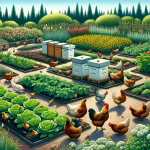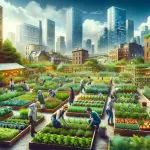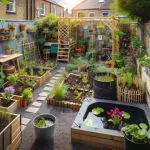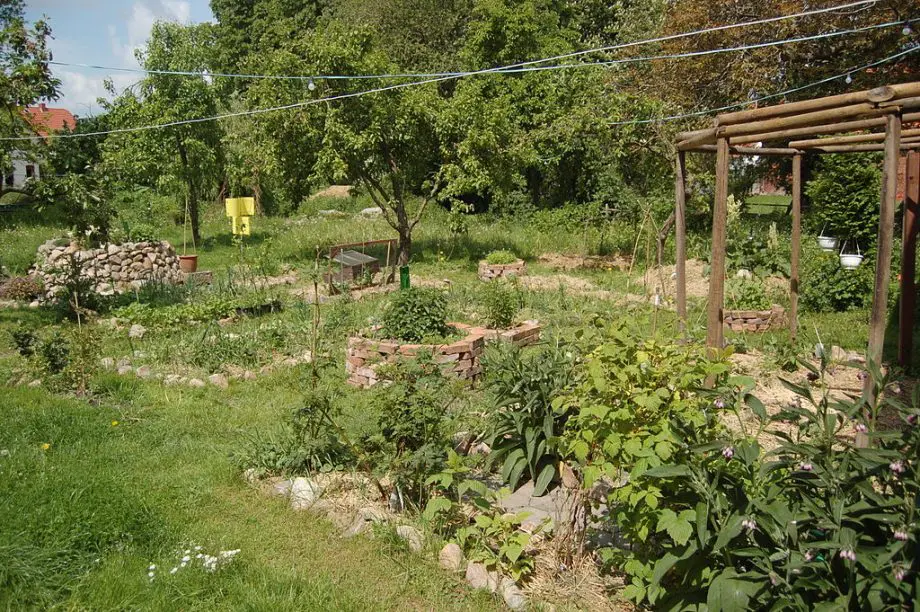
Dive into our guide to discover what is the main goal of permaculture, its principles, and practical applications for a sustainable lifestyle. Join the green revolution!
Permaculture Main Goals Key Takeaways:
- The main goal of permaculture is to create sustainable, self-sufficient ecosystems that align human activities with natural processes.
- It focuses on ecological balance, efficient use of resources, and the creation of resilient, productive environments that cater to both human needs and environmental conservation.
Welcome to our journey into the world of sustainable living! Today, we’re exploring the main goal of permaculture, a transformative approach that harmonizes our lives with nature.
This guide will unveil how permaculture reshapes our interaction with the environment, promoting a healthier, greener future.
What is the Main Goal of Permaculture?
Permaculture, a term coined by David Holmgren and Bill Mollison, is a design system that harmonizes human activity with the natural environment.
This comprehensive guide delves into the principles of permaculture, its benefits, and practical applications.
We’ll explore how permaculture fosters sustainable agriculture, organic farming, and a sustainable lifestyle, addressing the urgent need for a shift in how we view our relationship with nature.
Whether you’re an enthusiastic gardener or a permaculture enthusiast, this pillar post will provide valuable insights into creating sustainable systems that meet human needs while preserving the natural ecosystem.
Permaculture One by Bill Mollison and David Holmgren
I. Understanding Permaculture
Permaculture is a transformative approach to sustainable living, conceptualized by visionaries David Holmgren and Bill Mollison.
It integrates principles of permaculture with natural ecosystems, aiming to create a harmonious balance between human needs and the environment.
This section delves into the core concepts, principles, and historical roots of permaculture, laying the foundation for its practical applications in our daily lives.
Definition and Origins
Permaculture, a term coined in the 1970s, merges ‘permanent agriculture’ with ‘permanent culture.’
It was developed by David Holmgren, a young graduate student, and his professor, Bill Mollison, in response to the destructive impacts of modern agriculture on the environment.
The concept of permaculture was born from a need to create sustainable, self-sufficient systems that mimic natural ecosystems, providing a blueprint for sustainable living and organic farming.
Core Principles of Permaculture
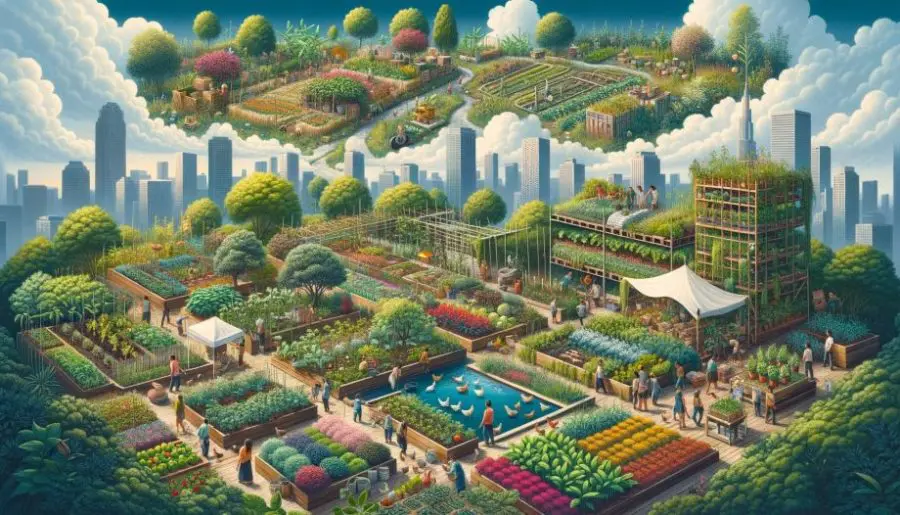
The principles of permaculture are guidelines that help design sustainable systems.
They are derived from the observation of natural ecosystems, emphasizing the importance of working with nature rather than against it.
Key principles include ‘observe and interact,’ ‘catch and store energy,’ and ‘use and value diversity.’
These principles encourage a holistic approach, considering different elements like soil health, water management, and the integration of fruit trees and perennial plants in garden design.
How Permaculture Differs from Traditional Agriculture
Permaculture stands apart from traditional agriculture through its focus on sustainable agriculture and long-term ecological balance.
Unlike conventional methods that often rely on chemical fertilizers and fossil fuels, permaculture emphasizes renewable resources, organic matter, and the creation of permaculture gardens that support biodiversity and soil fertility.
This design approach promotes a sustainable way of living, reducing reliance on non-renewable resources and fostering a deeper connection with the natural world.
II. The Main Goal of Permaculture

At its heart, permaculture is about creating sustainable, self-sufficient ecosystems that meet human needs while nurturing the environment.
This section will explore the primary objective of permaculture, examining how it integrates diverse natural systems into productive landscapes, aligning human activities with the rhythms of nature.
Creating Sustainable and Self-sufficient Ecosystems
The foremost aim of permaculture is to establish ecosystems that are not only sustainable but also self-sufficient.
This involves designing systems, like permaculture gardens, that can regenerate themselves, mimicking the resilience and diversity of natural ecosystems.
The use of renewable resources, organic farming practices, and the integration of food forests and crop rotation are central to achieving this goal.
The Role of Diversity in Permaculture Systems
Diversity is a cornerstone in permaculture design, echoing the complex interrelationships found in nature.
By incorporating different plants, animal species, and natural processes, permaculture systems gain the resilience and adaptability of natural ecosystems.
This diversity also plays a crucial role in pest control, soil fertility, and the overall health of the system, reducing the need for external inputs like chemical fertilizers.
Integration of Human Activity with Natural Surroundings
Permaculture seeks to harmonize human activities with the natural world, advocating for a sustainable way of life that respects and enhances the environment.
This involves designing living spaces and agricultural systems that align with natural patterns, utilizing local materials, and applying slow solutions for long-term sustainability.
In urban areas and rural settings alike, permaculture’s holistic approach helps in creating living systems that are both productive and ecologically sound.
III. Benefits of Permaculture
Permaculture offers a myriad of benefits that extend beyond the individual garden to the global environment and community.
This section highlights how permaculture contributes to environmental sustainability, community development, and economic resilience, showcasing its role as a key player in addressing climate change and promoting a sustainable future.
Environmental Benefits
Permaculture’s emphasis on natural systems and organic practices leads to significant environmental benefits.
By mimicking natural ecosystems, permaculture gardens enhance biodiversity and soil health, contributing to the overall health of the planet.
Practices like using organic matter, conserving water, and reducing reliance on fossil fuels help in combating climate change.
Permaculture also plays a vital role in sustainable land management, preserving natural resources for future generations.
Social and Community
Advantages Permaculture extends its reach into social realms, fostering community development and cooperation.
Community gardens and shared permaculture projects encourage local engagement, building a sense of community and shared responsibility.
This approach also supports fair share ethics, ensuring that resources are used responsibly and benefits are distributed equitably.
Permaculture’s principles can be applied in various settings, from urban environments to rural communities, promoting sustainable development and a sense of belonging.
Economic Sustainability and Resilience
Economically, permaculture offers a sustainable alternative to conventional agriculture.
By encouraging the production of one’s own food and reducing dependence on store-bought products, it provides a means of economic empowerment and resilience.
The use of local and renewable resources, coupled with sustainable practices like crop rotation and rotational grazing, leads to reduced costs and sustainable yield over time.
Permaculture also opens up opportunities for small-scale, sustainable businesses, contributing to a robust and resilient local economy.
IV. Implementing Permaculture in Your Life

Integrating permaculture into your daily life can be a rewarding journey towards sustainable living.
Whether you’re in an urban setting or have access to more land, permaculture principles can be adapted to fit different environments.
This section offers practical tips on starting your permaculture journey, from small-scale gardens to larger community initiatives.
Starting Small: Permaculture in Home Gardens
Beginning with a small permaculture garden is a great way to introduce sustainable practices into your life.
Utilize permaculture design principles to create a garden that maximizes the use of available resources.
Incorporate elements like fruit trees, perennial plants, and organic matter to improve soil fertility and create a self-sustaining ecosystem.
Even in limited spaces, permaculture techniques like vertical gardening and container planting can be employed to grow healthy food.
Urban Permaculture: Adapting Techniques for City Living
Permaculture isn’t confined to rural settings; it’s equally applicable in urban areas.
Urban permaculture focuses on maximizing the use of small spaces, such as balconies or rooftops, and harnessing urban resources like rainwater.
Implementing water management systems, growing different plants together for mutual benefit, and using natural methods for pest control can transform urban spaces into productive, green areas.
Community Initiatives and Collaboration
Permaculture is not just about individual efforts; it thrives on community involvement.
Participating in or initiating community gardens is a great way to spread the principles of permaculture.
These gardens serve as good examples of ecological design and sustainable practices, fostering a sense of community and shared learning.
Collaborative efforts in community development through permaculture also lead to larger-scale positive impacts, both environmentally and socially.
Through these approaches, permaculture becomes more than just a gardening technique; it evolves into a sustainable way of life, connecting us more deeply with our natural surroundings and our communities.
V. Case Studies: Successful Permaculture Projects
Exploring real-world examples of permaculture projects provides valuable insights into the practical application and impact of permaculture principles.
In this section, we’ll look at successful permaculture initiatives from local to international scales, highlighting how these projects have made a positive impact on their communities and the environment.
Local Success Stories
Local permaculture projects often start small but have a profound impact.
For instance, a community permaculture garden in an urban area might demonstrate effective land use and community development.
These projects often showcase sustainable practices like water management, organic gardening, and the use of natural materials, serving as inspirational models for others in the community.
International Permaculture Models
Internationally, permaculture has been applied in diverse settings, from permaculture farms in Sub-Saharan Africa to large-scale sustainable agriculture projects in Australia.
These models often incorporate holistic approaches to food production systems, land management, and ecological design, addressing global challenges like food security and climate change.
They often serve as good examples of permaculture’s versatility and effectiveness in different climates and cultures.
Lessons Learned and Best Practices
Every permaculture project offers unique lessons and best practices. Common themes include the importance of adapting to local environments, the value of diversity in ecosystems, and the long-term benefits of sustainable practices.
These case studies also highlight the importance of community involvement and the positive impact that permaculture can have on sustainable living and sustainable development.
These case studies not only illustrate the practical applications of permaculture principles but also inspire and motivate individuals and communities to adopt permaculture practices in their own lives, contributing to a more sustainable and resilient future.
Here is a list of some case studies you can read about them here.
- The Greening the Desert Project, Jordan: This renowned project, led by Geoff Lawton, transformed a barren landscape in Jordan into a sustainable oasis. It utilized techniques like swales, rainwater harvesting, and soil regeneration to create a flourishing ecosystem capable of supporting abundant food production. This project is a powerful example of permaculture’s effectiveness in challenging environments.
- Zaytuna Farm, Australia: Managed by Geoff and Nadia Lawton, Zaytuna Farm in New South Wales is a renowned permaculture education center. It showcases a variety of permaculture techniques, including swales, keyline design, and integrated animal systems. The farm is known for its regenerative agriculture practices, creating a diverse and resilient ecosystem.
- Finca Luna Nueva, Costa Rica: This biodynamic and organic farm exemplifies the large-scale application of permaculture principles. It integrates agroforestry, organic agriculture, and permaculture design, utilizing practices like biochar production and natural pest control. Finca Luna Nueva demonstrates permaculture’s potential in ecological regeneration and sustainable agriculture.
- The Bullock Brothers Homestead, United States: Located on Orcas Island, Washington, this permaculture project focuses on self-sufficiency and resilience. It employs permaculture design principles alongside techniques such as rainwater harvesting and solar energy, creating a sustainable and abundant living system.
- Sadhana Forest, India: Situated in Tamil Nadu, this reforestation project uses permaculture principles to restore degraded land. It involves planting native trees, implementing water conservation techniques, and promoting sustainable living practices. Sadhana Forest has successfully regenerated a barren landscape into a thriving forest ecosystem.
These case studies highlight the versatility and global impact of permaculture, demonstrating its effectiveness in various environments and cultures.
VI. Overcoming Challenges in Permaculture
Practical Permaculture: for Home Landscapes, Your Community, and the Whole Earth
While permaculture offers a sustainable path toward environmental harmony and community resilience, practitioners often face various challenges.
This section addresses common obstacles encountered in permaculture projects, offering solutions and resources to help navigate these hurdles effectively.
Common Obstacles and Solutions
Permaculture practitioners might face challenges like limited space in urban areas, lack of access to natural materials, or difficulties in implementing water management systems.
Solutions include creative use of space, such as vertical gardens or container planting, sourcing local materials, and employing innovative water conservation techniques.
Overcoming these challenges often requires a combination of good design, adaptability, and community support.
Learning and Adapting to Local Environments
One of the key aspects of permaculture is its adaptability to different environments.
Practitioners need to understand their local climate, soil conditions, and available resources to create effective permaculture systems.
This might involve learning about native plant species, adapting techniques to local conditions, or experimenting with different elements to see what works best.
Online courses, local workshops, and permaculture groups can provide valuable knowledge and support in this learning process.
Resources and Support for Permaculture Practitioners
To successfully implement and maintain permaculture projects, practitioners require access to resources and support networks.
Resources might include educational materials, tools for garden design, and information on sustainable practices.
Support can come from local permaculture communities, online forums, and organizations dedicated to sustainable living and permaculture.
Collaborating with other permaculture enthusiasts and designers can also provide mutual support and knowledge sharing, helping to foster a stronger and more resilient permaculture community.
Overcoming these challenges not only enhances the success of individual permaculture projects but also contributes to the broader movement toward sustainable living and ecological balance.
FAQs: Navigating the World of Permaculture
Permaculture is a vast and dynamic field, often raising questions among beginners and seasoned practitioners alike.
In this FAQ section, we aim to address some of the most common inquiries about permaculture.
From understanding its core principles to applying them in various settings, these questions and answers will provide deeper insights into the world of permaculture, helping you navigate its practices more effectively.
Q: What exactly is permaculture, and how does it differ from traditional farming?
A: Permaculture is a sustainable design system that integrates land, resources, people, and the environment through mutually beneficial synergies.
It differs from traditional farming by emphasizing perennial plants, diversity, natural ecosystems, and sustainability.
Unlike conventional agriculture, which often relies on chemical inputs and monocultures, permaculture promotes organic practices, biodiversity, and renewable resources.
Q: Can permaculture be applied in urban environments?
A: Absolutely! Urban permaculture adapts principles like food production, waste reduction, and resource conservation to smaller, urban spaces.
Techniques like vertical gardens, rooftop farming, and container gardening are effective in cities.
Urban permaculture also includes community initiatives like shared gardens, which foster social connections and sustainable community development.
Q: How can I start a permaculture garden in my backyard?
A: Starting a permaculture garden involves observing your space, understanding local conditions, and designing your garden based on permaculture principles.
Begin by assessing sunlight, soil quality, and available space. Incorporate elements like composting, rainwater harvesting, and plant diversity.
Starting small with a few fruit trees and perennial plants is a great way to embark on your permaculture journey.
Q: Are there any online resources or courses for learning more about permaculture?
A: Yes, there are many online resources and courses available. Websites like The Permaculture Research Institute offer articles, case studies, and online courses.
Many universities and organizations also provide online courses ranging from introductory to advanced levels, covering topics like sustainable design, organic gardening, and water management.
Q: What role does permaculture play in combating climate change?
A: Permaculture plays a significant role in mitigating climate change by promoting practices that reduce carbon emissions and enhance carbon sequestration.
Techniques like organic farming, soil regeneration, and forest gardening help in capturing carbon dioxide.
Permaculture’s emphasis on sustainable and local food systems also reduces the carbon footprint associated with food production and transportation.
Through these FAQs, we hope to shed light on some of the key aspects of permaculture and its potential to create positive environmental and social change.
Whether you are new to permaculture or looking to deepen your practice, there is always more to learn and explore in this ever-evolving field.
The Main Goal of Permaculture Conclusion

Permaculture, a holistic approach to sustainable living, offers a path towards environmental harmony and community resilience.
Throughout this guide, we’ve explored the principles of permaculture, its main goals, benefits, practical implementations, successful case studies, and ways to overcome challenges.
Permaculture is not just a set of gardening techniques; it’s a philosophy that integrates sustainable agriculture, responsible land management, and community development.
The Journey
The journey of permaculture is a continuous learning process, adapting and evolving with each new challenge and success.
It encourages us to view the natural world not just as a resource, but as a partner in our quest for a sustainable future.
By embracing permaculture, we contribute to a more sustainable and equitable world, ensuring a healthy planet for future generations.
As we close this comprehensive guide, let us remember that each step towards permaculture, whether small or large, is a step towards a more sustainable lifestyle.
We encourage you to start where you are, use what you have, and do what you can. Join the growing community of permaculture practitioners and become part of the positive change.
Call to Action
- Start your own permaculture project, no matter the scale, and share your experiences with others.
- Connect with local permaculture communities and participate in collaborative efforts towards sustainable living.
Together, we can create a world where permaculture principles guide our interactions with the earth and each other, fostering a sustainable, resilient, and just society.




